Abstract
Advanced glycation end products (AGEs) arise from non-enzymatic reactions between extracellular proteins and glucose. AGEs’ formation occurs during normal ageing but distinctly accelerate with the progression of chronic disease. Pentosidine is a very sensitive marker for all AGEs. We investigated whether serum pentosidine was increased and correlated with healthy elderly individuals (80–102 years) and the disease groups (hypertension 60–77 years; and coronary artery disease 60–77 years). Measurement of serum pentosidine levels in healthy elderly individuals is n = 38, hypertensive patients n = 38, and coronary artery diseases n = 31(treated with drugs). Drugs for the treatment of CAD work as inhibitors of advanced glycation end products. Serum levels of pentosidine are measured by using sandwich ELISA. Serum pentosidine concentrations were significantly higher in hypertensive patients (1910.5 ± 302.6 pmol/ml) in comparison with healthy elderly individuals (1605.1 ± 596.5 pmol/ml) as well as in coronary artery disease (1495 ± 531.8 pmol/ml), p = .002. Within the age-dependent serum concentration of pentosidine was higher (2148.5 ± 209.8) p = 0.988 in hypertension (˃ 70 years). A multiple linear stepwise regression analysis concludes that in patients with hypertension, serum pentosidine was significantly influenced with the age (standardized β = 0.440, 95%CI: 5.49–30.05, p = .006). The receiver operating characteristic curves for the presence of hypertension diagnosis had an area under the curve (AUC) of 0.675; (95% CI: 0.575–0.775, p = .003). The optimal cutoff value of pentosidine was 1120 pmol/ml with 97.4% sensitivity and 76.8% specificity. Serum pentosidine is significantly associated with hypertension in the study group also within their age group. It may be due to atherosclerosis and arterial stiffness.


Similar content being viewed by others
References
Miyazawa T, Nakagawa K, Shimasaki S, Nagai R. Lipid glycation and protein glycation in diabetes and atherosclerosis. Amino Acids. 2012;42:1163–70.
Maillard L. Action des acides amines sur les sucres: formation des melanoidines par voie methodique. CR Acad Sci Paris. 1912;154:66–8.
Semba Richard D, Nicklett EJ, Ferrucci L. Does accumulation of advanced glycation end products contribute to the aging phenotype? J Gerontol Ser A Biomed Sci Med Sci. 2010;65:963–75.
Vlassara H, Palace MR. Diabetes and advanced glycation end products. J Intern Med. 2002;251:87–101.
Koyama H, Nishizawa Y. AGEs/RAGE in CKD: irreversible metabolic memory road toward CVD? Eur. J Clin Investig. 2010;40:623–35.
Verzijl N, Bank RA, TeKoppele JM, DeGroot J. AGEing and osteoarthritis: a different perspective. Curr Opin Rheumatol. 2003;15:616–22.
Koska J, Saremi A, Howell S, Bahn G, de Courten B, Ginsberg H, et al. Advanced Glycation end products, oxidation products, and incident cardiovascular events in patients with type 2 diabetes. Diabetes Care. 2018;41:570–6.
Erbersdobler Helmut F, Somoza V. Forty years of furosine–forty years of using Maillard reaction products as indicators of the nutritional quality of foods. Mol Nutr Food Res. 2007;51:423–30.
Spagnoli LG, Mauriello A, Orlandi A, Sangiorgi G, Bonanno E. Age-related changes affecting atherosclerotic risk. Drugs Aging. 1998;4:275–98.
Reeg S, Grune T. Protein oxidation in aging: does it play a role in aging progression? Antioxid Redox Signal. 2015;23:239–55.
Kerkeni M, Saïdi A, Bouzidi H, Yahya SB, Hammami M. Elevated serum levels of AGEs, sRAGE, and pentosidine in Tunisian patients with severity of diabetic retinopathy. Microvasc Res. 2012;3:378–83.
Haus JM, Carrithers JA, Trappe SW, Trappe TA. Collagen, cross-linking and advanced glycation end products in aging human skeletal muscle. J Appl Physiol. 2007;103:2068–76.
Kerkeni M, Saïdi A, Bouzidi H, Letaief A, Ben Yahia S, Hammami M. Pentosidine as a biomarker for microvascular complications in type 2 diabetic patients. Diab Vasc Dis Res. 2013;3:239–45.
Yoshida N, Okumura K, Aso Y. High serum pentosidine concentrations are associated with increased arterial stiffness and thickness in patients with type 2 diabetes. Metabolism. 2005;54:345–50.
Yamagishi S, et al. Advanced glycation end products-driven angiogenesis in vitro. Induction of the growth and tube formation of human microvascular endothelial cells through autocrine vascular endothelial growth factor. J Biol Chem. 1997;272:8723–30.
Birlouez-Aragon I, Saavedra G, Tessier FJ, Galinier A, Ait-Ameur L, Lacoste F, et al. A diet based on high-heat-treated foods promotes risk factors for diabetes mellitus and cardiovascular diseases. Am J Clin Nutr. 2010;91:1220–6.
Kerkeni M, Weiss IS, Jaisson S, Dandana A, Addad F, Gillery P, et al. Increased serum concentrations of pentosidine are related to presence and severity of coronary artery disease. Thromb Res. 2014;3:633–8.
Nenna A, et al. Pharmacologic approaches against advanced glycation end products (AGEs) in diabetic cardiovascular disease. Res Cardiovasc Med. 2015;4:e26949.
Stirban A, Negrean M, Stratmann B, Gawlowski T, Horstmann T, Götting C, et al. Benfotiamine prevents macro-and microvascular endothelial dysfunction and oxidative stress following a meal rich in advanced glycation end products in individuals with type 2 diabetes. 2006;9:2064–71.
Colhoun HM, Betteridge DJ, Durrington PN, Hitman GA, Neil HA, Livingstone SJ, et al. Cards investigators. Primary prevention of cardiovascular disease with atorvastatin in type 2 diabetes in the collaborative atorvastatin diabetes study (CARDS): multicentre randomised placebo-controlled trial. Lancet. 2004;9435:685–96.
Lonn E, Gerstein HC, Smieja M, Mann JF, Yusuf S. Mechanisms of cardiovascular risk reduction with ramipril: insights from HOPE and HOPE substudies. Eur Heart J Suppl. 2003;5:A43–8.
Byun K, Yoo YC, Son M, Lee J, Jeong GB, Park YM, et al. Advanced glycation end-products produced systemically and by macrophages: a common contributor to inflammation and degenerative diseases. Pharmacol Ther. 2017;177:44–55.
Miyata T, et al. Accumulation of albumin-linked and free-form pentosidine in the circulation of uremic patients with end-stage renal failure: renal implications in the pathophysiology of pentosidine. J Am Soc Nephrol. 1996;7:1198–206.
Funding
This work was supported by Department of Medicine, Institute of Medical Sciences, Banaras Hindu University India and the University Grant Commission Rajiv Gandhi National Fellowship (UGC-RGNF).
Author information
Authors and Affiliations
Contributions
Conceptualization: Dr. Indrajeet Singh Gambhir and Neelam Tia, Methodology: Neelam Tia, Chandra Shekhar Azad and Pritee Chaudhary, Formal analysis and investigation: Neelam Tia and Moti Lal, Writing: Neelam Tia, Writing - review and editing: Neelam Tia, Manish Singh, Funding acquisition: National Programme for Healthcare of the elderly (NPHCE) government of India and the University Grant Commission Rajiv Gandhi National Fellowship (UGC-RGNF). Supervision: Dr. Indrajeet Singh Gambhir
Corresponding author
Ethics declarations
Conflict of Interests
NT, ML, CSA, PC, MS and ISG have no conflict of interests that are directly relevant to the contents of this article.
Additional information
Publisher’s Note
Springer Nature remains neutral with regard to jurisdictional claims in published maps and institutional affiliations.
This article is part of the Topical Collection on Medicine
Rights and permissions
About this article
Cite this article
Tia, N., Lal, M., Azad, C.S. et al. Serum Pentosidine Level in Healthy Ageing and Its Association with Age-Related Disease. SN Compr. Clin. Med. 2, 2253–2259 (2020). https://doi.org/10.1007/s42399-020-00564-x
Accepted:
Published:
Issue Date:
DOI: https://doi.org/10.1007/s42399-020-00564-x




